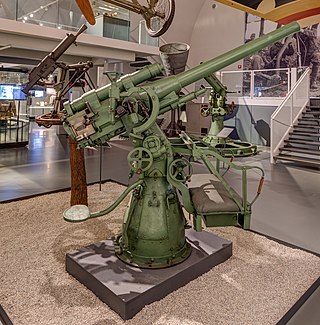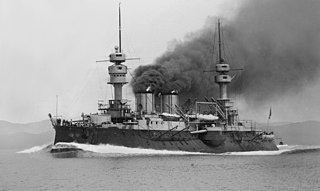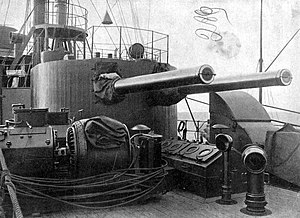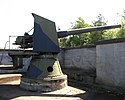
The Cannone da 152/45 modello 1911 was an Italian naval gun built by the Ansaldo company. It formed the secondary armament of the two Andrea Doria-class dreadnought battleships built during World War I. A number of guns were also converted to siege artillery and coastal artillery roles and served during both world wars.

The Canon de 164 mm Modèle 1893 was a medium-caliber naval gun used as the secondary armament of a number of French pre-dreadnoughts and armoured cruisers during World War I. It was used as railway artillery in both World Wars and as coastal artillery in World War II.

The 6 inch 35 caliber naval gun 1877 was a 152 mm naval gun used by the Russian Empire. The gun was used from 1887 as battleship secondary armament and cruiser armament. The gun was mostly replaced by newer 6 inch 45 caliber Canet gun 1892 at the time of the Russo-Japanese War, but was still used on some ships. During the First World War fourteen guns were used as coastal guns on Gulf of Finland in the Peter the Great's Naval Fortress and were taken over by Finland after Finland's Declaration of Independence in 1917. The guns were used by Finland in the Second World War. Russian model year 1877 refers to rifling system, not gun adoption.

The 130 mm/50 B13 Pattern 1936 was a 130 mm (5.1 in) 50 caliber Soviet naval gun. The weapon was the standard primary armament of Soviet-built destroyers from about 1935 to 1954, and it was also utilized as a coastal gun and railway gun. The gun was produced in three different versions which all had incompatible ammunition and range tables. Mountings for the weapon included single open mounts and twin turrets. Besides the Soviet Union, the gun was used on ships sold or donated to Poland, People's Republic of China, Egypt and Indonesia. Finland captured five guns during the Continuation War and used them until the 1990s.

The Canon de 194 mm Modèle 1902 was a medium-caliber naval gun used as the primary or secondary armament in both casemates and turrets of a number of French pre-dreadnoughts and armored cruisers during World War I. After World War I these ships were scrapped and some were later reused as coastal artillery in World War II
The Škoda 15 cm K10 was a naval gun of the Austro-Hungarian Empire that was used by the Austro-Hungarian Navy during World War I. The gun was actually 149.1 mm, but the classification system for artillery rounded up to the next highest centimeter. The 15 cm K10 was called cannon 149/47 by the Italians and was used by the Italian Navy as coastal artillery during World War II.

The Škoda 7 cm K10 was a dual-purpose gun of the Austro-Hungarian Empire that was used by the Austro-Hungarian Navy during World War I. The gun was actually 66 mm, but the classification system for artillery rounded up to the next highest centimeter. The 7 cm K10 was also used by the Italian Navy on ships ceded as war reparations and as coastal artillery during World War II. The Italians referred to it as the 66/47.

The EOC 8 inch 45 caliber were a family of related 8-inch (203 mm) 45 caliber naval guns designed by the Elswick Ordnance Company and manufactured by Armstrong for export customers before World War I. In addition to being produced in the United Kingdom licensed variants were produced in Italy and in Japan. Users of this family of gun included the navies of Argentina, Chile, China, Italy, Japan and Spain. This family of guns saw action in the Spanish–American War, Boxer Rebellion, Russo-Japanese War, Italo-Turkish War, World War I and World War II. In addition to its naval role it was later used as coastal artillery and siege artillery after the ships it served on were decommissioned.

The 15 cm Schnelladekanone Länge 35, abbreviated as 15 cm SK L/35, was a German naval gun developed in the years before World War I. 'Schnelladekanone' means that is was an (early) type of Quick-firing gun. The 15 cm SK L/35 armed a variety of warships from different nations. The navies of Austria-Hungary, China, Denmark, Japan, The Netherlands, The Ottoman Empire, and Romania all used this gun.

The 120mm 45 caliber Pattern 1892 was a Russian naval gun developed in the years before the Russo-Japanese War that armed a variety of warships of the Imperial Russian Navy during the Russo-Japanese War and World War I. Guns salvaged from scrapped ships found a second life on river gunboats of the Soviet Navy during the Russian Civil War and as coastal artillery and railway artillery during World War II. It was estimated that in 1941 there were 35 still in service.

The 203 mm 45 caliber Pattern 1892 was a Russian naval gun developed in the years before the Russo-Japanese War that armed a variety of warships of the Imperial Russian Navy during the Russo-Japanese War and World War I. Guns salvaged from scrapped ships found a second life as coastal artillery. It is believed none were in service during World War II.

The 75 mm 50 caliber Pattern 1892 was a Russian naval gun developed in the years before the Russo-Japanese War that armed the majority of warships of the Imperial Russian Navy during the Russo-Japanese War and World War I. The majority of ships built or refit between 1890 and 1922 carried Pattern 1892 guns. During its career the role of the guns evolved from one of anti-torpedo boat defense to coastal artillery and anti-aircraft use.

The Canon de 100 mm Modèle 1891 was a French naval gun developed in the late 1800s that armed a variety of warships before World War I and during World War II. In addition to its naval role it was also deployed as coastal artillery.

The Canon de 65 mm Modèle 1891 & Modèle 1902 were a family of widely used naval guns of the French Navy that were also used by the Ottoman Navy during World War I. Guns removed from decommissioned ships also saw use as coastal artillery and as fortress guns in the Maginot Line fortifications during World War II.

The 203 mm 50 caliber Pattern 1905 was a Russian naval gun developed by Vickers for export in the years before World War I that armed a variety of warships of the Imperial Russian Navy. Guns salvaged from scrapped ships found a second life as coastal artillery, railway artillery and aboard river monitors during the Russian Civil War. By 1941 it was estimated there were 36 coastal defense guns and two railroad mounts remaining. During the 1930s a number were relined down to 180 mm (7.1 in) and re-designated the 180mm Pattern 1931-1933. These guns were used aboard Kirov-class cruisers or as coastal artillery and railway artillery.

The 120 mm 50 caliber Pattern 1905 was a Russian naval gun developed by Vickers for export in the years before World War I that armed a variety of warships of the Imperial Russian Navy. Guns salvaged from scrapped ships found a second life as coastal artillery, railway artillery and aboard river monitors during the Russian Civil War. It was estimated that there were 110 guns in the Soviet Navy's inventory in 1941. Of these, 39 were in the Baltic Fleet, 20 in the Black sea Fleet, 24 in the Amur Flotilla, 11 in the Pacific Fleet and 6 in the Pinsk flotilla in World War II.
The 15 cm/45 41st Year Type was a British naval gun designed by the Elswick Ordnance Company for export in the years before World War I that armed warships of the Imperial Japanese Navy. These guns served aboard Japanese ships during World War I and as coastal artillery during World War II.
The Cannon 152/32 Model 1887 was an Italian naval gun designed by the Elswick Ordnance Company and produced by Armstrong Whitworth in the late 1880s for the Italian Navy.

The Canon de 305 mm Modèle 1887 was a heavy naval gun used as the main armament of a number of French pre-dreadnoughts and coastal defense ships during World War I. Eight were converted to railway artillery in World War I and four were used during World War II.

The Canon de 274 modèle 1887/1893 were a family of French naval guns developed in the years before World War I that armed a variety of warships of the French Navy. Guns salvaged from scrapped ships found a second life as coastal artillery and railway artillery during World War I and World War II.























